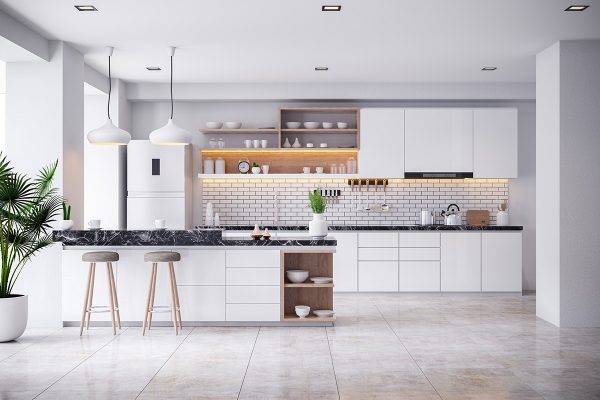When it comes to choosing flooring for a commercial or residential new-build or renovation project, the choices are almost endless!
And, with underfloor heating becoming increasingly popular due to its energy-efficiency and compliance with new building regulations, the common question is which type of flooring is most suitable for this sought-after heating method?
The good news is, underfloor heating can be used with almost any flooring type!
As leading suppliers of underfloor heating to the trade, we’ve taken a look at the most popular flooring options and their suitability for use with underfloor heating.
What is the best flooring for underfloor heating?
Generally speaking, the best floor covering for underfloor heating is one which is thermally conductive, meaning heat is quickly and efficiently transferred to the surface of the floor.
Some of the most popular options include:
Ceramic and stone tiles
Due to their efficient transfer of heat to the surface of the floor, the best floor coverings for use with underfloor heating are no doubt hard surfaces such as tiles.
However, it’s important to note that different types of tiles have different properties, making some more suitable for underfloor heating than others.
Stone and ceramic tend to be the best choice as they are the most thermally conductive, whilst also offering the high-end, easy to clean and durable finish many people look for.
Tile and stone also retain heat well, making the whole underfloor heating system more efficient – and keeping energy bills low!
Read our blog to find out why tile flooring is a great choice for underfloor heating:
Vinyl and linoleum
Both vinyl and linoleum (or lino) floorings work particularly well with underfloor heating due to their thin nature, which enables heat to easily permeate the floor to warm the room.
Whilst not quite as thermally conductive or hardwearing as ceramic tiles, vinyl and lino do offer a more affordable flooring option.
However, while vinyl is a cheaper alternative, it is still hardwearing, making it ideal for high traffic areas such as kitchens and bathrooms.
Also, vinyl floor tiles are a stylish and durable partner for use with underfloor heating and can create a luxury finish – often mimicking natural floor coverings such as hardwood, tiles or even granite.
Linoleum (or lino) flooring is made from renewable, natural materials such as linseed oil, cork and wood – making it the ideal flooring choice for eco-conscious customers.
Both vinyl and lino provide a seamless, durable and aesthetically pleasing floor finish, ideal for use with underfloor heating.
Wood
Wooden floors are a popular choice for many new-builds or renovations.
With their sleek and elegant look, they perfectly complement modern commercial buildings and homes, whilst offering high heat transfer too.
All types of wooden flooring are suitable for use with underfloor heating but engineered timber is often the best choice because it copes well with changes in floor temperature.
This is because the underneath of the wood plank is made from base layers which give strength and stability, allowing the floor to expand and contract with changes in temperature.
Engineered wood also has many aesthetic benefits, making it a desirable floor finish. It’s timeless, adds visual warmth and comes in a wide range of colours, patterns, grains and plank sizes to choose from.
Whether you’re choosing engineered wood or solid hardwood, attention should be paid to the thickness of the floorboards to avoid them acting as insulation and blocking the heat.
Carpet
Many people assume that underfloor heating only works with hard flooring such as tiles and laminate. This is not true!
In fact, there are many benefits to using carpet as the flooring choice for underfloor heating.
It’s soft and warm underfoot, which makes a room feel extra cosy. This makes carpets the ideal flooring choice for use in living rooms and bedrooms.
Combining carpets with underfloor heating has hygiene benefits too.
Whilst radiators can release dust particles from the carpet by circulating the air around the room, underfloor heating heats from the ground up – helping to ensure dust in the carpet does not enter the air.
With dust particles often the cause of coughing, sneezing and itchy eyes for people suffering with allergies, underfloor heating is a healthier way to heat a room.
When choosing carpet for use with underfloor heating, there are a few things which should be considered, such as the type of carpet used, the tog rating and the underlay.
If a carpet is too thick, the floor will be too well insulated to feel the heat coming through, reducing the efficiency of the underfloor heating system. The combined tog rating of the carpet and underlay should therefore not exceed 2.5 tog.
When choosing carpet, the use of a thermostat to regulate the temperature is essential. Here at Amber, we offer a range of thermostats which make controlling underfloor heating a simple task.
From our Touch Thermostat to our new Wi-Fi App-controlled thermostat, we can offer an option to suit any underfloor heating system.
Looking for underfloor heating? Amber can help!
Backed by over 30 years’ experience, we are the UK and Ireland’s leading supplier of electric underfloor heating to the trade, reaching tradespeople through our comprehensive network of stockists.
We supply highly efficient, effective and durable electric underfloor heating systems through wholesalers, distributers and kitchen, bathroom and tile showrooms.
Alongside our unique and comprehensive range of Amber branded products, we are also the leading supplier of DEVI products in the UK and Ireland.
For more information about Amber Underfloor Heating, get in touch today.








